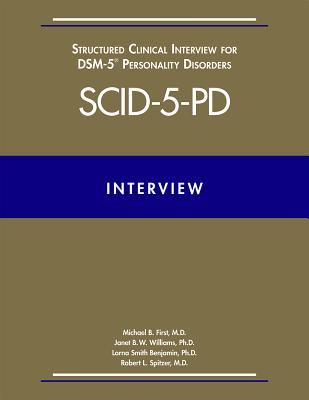Structured Clinical Interview for Dsm-5(r) Personality Disorders (Scid-5-Pd)

Structured Clinical Interview for Dsm-5(r) Personality Disorders (Scid-5-Pd)
The Structured Clinical Interview for DSM-5(R) Personality Disorders (SCID-5-PD) is a semistructured diagnostic interview for clinicians and researchers to assess the 10 DSM-5 Personality Disorders across Clusters A, B, and C as well as Other Specified Personality Disorder. Designed to build rapport, the SCID-5-PD can be used to make personality disorder diagnoses, either categorically (present or absent) or dimensionally. The SCID-5-PD includes interview and the handy self-report screening questionnaire for patients or subjects, the Structured Clinical Interview for DSM-5(R) Screening Personality Questionnaire (SCID-5-SPQ).The SCID-5-PD is the updated version of the former Structured Clinical Interview for DSM-IV Axis II Personality Disorders (SCID-II). The SCID-5-PD name reflects the elimination of the multiaxial system in DSM-5. Although the DSM-IV Personality Disorder criteria are unchanged in DSM-5, the SCID-5-PD interview questions have been thoroughly reviewed and revised to optimally capture the construct embodied in the diagnostic criteria. In addition, a dimensional scoring component has been added to the SCID-5-PD.The basic structure of the SCID-5-PD is similar to the other SCID-5 interviews (such as the Research Version, SCID-5-RV; and the Clinician Version, SCID-5-CV) that cover non-personality DSM-5 disorders. Features include the following: - Questions assessing the DSM-5 criteria for each of the 10 personality disorders: Avoidant Personality Disorder, Dependent Personality Disorder, Obsessive-Compulsive Personality Disorder, Paranoid Personality Disorder, Schizotypal Personality Disorder, Schizoid Personality Disorder, Histrionic Personality Disorder, Narcissistic Personality Disorder, Borderline Personality Disorder, and Antisocial Personality Disorder.- An optional SCID-5-SPQ that serves as a brief, 20-minute self-report screening tool to reduce the time of the SCID-5-PD clinical interview. The SCID-5-SPQ requires an eighth grade or higher reading level (as determined by the Flesch-Kincaid formula). Its 106 questions correspond directly to each first question in the full SCID-5-PD. The SCID-5-PD can be used in various types of research studies, just as the SCID-II. It has been used to investigate patterns of Personality Disorders co-occurring with other mental disorders or medical conditions; select a group of study subjects with a particular Personality Disorder; investigate the underlying structure of persona
![]() 24-48h
24-48h
PRP: 460.80 Lei
Acesta este Prețul Recomandat de Producător. Prețul de vânzare al produsului este afișat mai jos.
368.64Lei
368.64Lei
460.80 LeiÎn stoc

Comandă până la 14:00:
Descrierea produsului
The Structured Clinical Interview for DSM-5(R) Personality Disorders (SCID-5-PD) is a semistructured diagnostic interview for clinicians and researchers to assess the 10 DSM-5 Personality Disorders across Clusters A, B, and C as well as Other Specified Personality Disorder. Designed to build rapport, the SCID-5-PD can be used to make personality disorder diagnoses, either categorically (present or absent) or dimensionally. The SCID-5-PD includes interview and the handy self-report screening questionnaire for patients or subjects, the Structured Clinical Interview for DSM-5(R) Screening Personality Questionnaire (SCID-5-SPQ).The SCID-5-PD is the updated version of the former Structured Clinical Interview for DSM-IV Axis II Personality Disorders (SCID-II). The SCID-5-PD name reflects the elimination of the multiaxial system in DSM-5. Although the DSM-IV Personality Disorder criteria are unchanged in DSM-5, the SCID-5-PD interview questions have been thoroughly reviewed and revised to optimally capture the construct embodied in the diagnostic criteria. In addition, a dimensional scoring component has been added to the SCID-5-PD.The basic structure of the SCID-5-PD is similar to the other SCID-5 interviews (such as the Research Version, SCID-5-RV; and the Clinician Version, SCID-5-CV) that cover non-personality DSM-5 disorders. Features include the following: - Questions assessing the DSM-5 criteria for each of the 10 personality disorders: Avoidant Personality Disorder, Dependent Personality Disorder, Obsessive-Compulsive Personality Disorder, Paranoid Personality Disorder, Schizotypal Personality Disorder, Schizoid Personality Disorder, Histrionic Personality Disorder, Narcissistic Personality Disorder, Borderline Personality Disorder, and Antisocial Personality Disorder.- An optional SCID-5-SPQ that serves as a brief, 20-minute self-report screening tool to reduce the time of the SCID-5-PD clinical interview. The SCID-5-SPQ requires an eighth grade or higher reading level (as determined by the Flesch-Kincaid formula). Its 106 questions correspond directly to each first question in the full SCID-5-PD. The SCID-5-PD can be used in various types of research studies, just as the SCID-II. It has been used to investigate patterns of Personality Disorders co-occurring with other mental disorders or medical conditions; select a group of study subjects with a particular Personality Disorder; investigate the underlying structure of persona
Detaliile produsului










